The Emission Characteristics of Greenhouse Gases from Animal Husbandry in Shandong Province Based on Life Cycle Assessment
Abstract
1. Introduction
2. Materials and Methods
2.1. Data Sources
2.2. Research Methods
2.3. Calculation of Greenhouse Gas Emission Amount in Animal Husbandry
2.3.1. Average Annual Feeding Amount
2.3.2. Calculation of Greenhouse Gas Emission Amount
2.3.3. Greenhouse Gas Emission Coefficient
2.4. Calculation of Greenhouse Gas Emission Intensity in Animal Husbandry
2.5. Statistical Analysis
3. Results
3.1. Variation in Greenhouse Gas Emission Amount and Emission Intensity
3.2. Variation in Greenhouse Gas Emission Structure
3.3. Regional Characteristics of Greenhouse Gas Emissions
3.3.1. Characteristics of Greenhouse Gas Emission Amount and Emission Intensity in Each City
3.3.2. Structural Characteristics of Greenhouse Gas Emission in Each City
3.3.3. Regional Characteristics of Greenhouse Gas Emission
4. Discussion
4.1. Temporal Characteristics of Greenhouse Gas Emissions in Animal Husbandry in Shandong Province
4.2. Structural Characteristics of Greenhouse Gas Emissions in Animal Husbandry in Shandong Province
4.3. Regional Characteristics of Greenhouse Gas Emissions in Animal Husbandry in Shandong Province
5. Conclusions
Author Contributions
Funding
Institutional Review Board Statement
Informed Consent Statement
Data Availability Statement
Conflicts of Interest
References
- He, Z.; Cao, H.; Qi, C.; Hu, Q.; Liang, J.; Li, Z. Straw management in paddy fields can reduce greenhouse gas emissions: A global meta-analysis. Field Crops Res. 2024, 306, 109218. [Google Scholar] [CrossRef]
- Gao, T. Yulin develops green animal husbandry to promote carbon reduction and efficiency improvement. Environ. Econ. 2022, 22, 57–59. [Google Scholar]
- Shandong Statistical Yearbook. 2002–2021. Available online: http://tjj.shandong.gov.cn/col/col6279/index.html (accessed on 12 April 2023).
- Central Document No.1. 2022. Available online: http://www.lswz.gov.cn/html/xinwen/2023-02/13/content_273655.shtml (accessed on 15 April 2023).
- The 14th Five-Years Plan for National Economic and Social Development and the Outline of the Long-term Goals for 2035 in Shandong Province. 2021. Available online: https://www.ndrc.gov.cn/fggz/fzzlgh/dffzgh/202105/t20210513_1279758.html (accessed on 2 May 2023).
- The 14th Five-Years Plan for Prevention and Control of Livestock and Poultry Breeding Pollution in Shandong Province. 2022. Available online: https://www.sdepi.org.cn/qydt/zcfg/1908.html (accessed on 3 May 2023).
- Charles, R.; Jolliet, O.; Gaillard, G.; Pellet, D. Environmental analysis of intensity level in wheat crop production using life cycle assessment. Agric. Ecosyst. Environ. 2006, 113, 216–225. [Google Scholar] [CrossRef]
- Zeng, D.; Cao, H.J.; Ma, C.M.; Hauschild, M.Z.; Dong, Y. A dynamic approach for life cycle global warming impact assessment of machine tool considering time effect. Int. J. Life Cycle Assess. 2021, 26, 1391–1402. [Google Scholar] [CrossRef]
- Brentrup, F.; Küsters, J.; Kuhlmann, H.; Lammel, J. Application of the Life Cycle Assessment methodology to agricultural production: An example of sugar beet production with different forms of nitrogen fertilisers. Eur. J. Agron. 2001, 14, 221–233. [Google Scholar] [CrossRef]
- Brentrup, F.; Küsters, J.; Kuhlmann, H.; Lammel, J. Environmental impact assessment of agricultural production systems using the life cycle assessment methodology: I. Theoretical concept of a LCA method tailored to crop production. Eur. J. Agron. 2004, 20, 247–264. [Google Scholar] [CrossRef]
- Ji, C. Two Large-Scale Farm Manure Disposal Systems’ Environmental Impact Assessment of Life Cycle—A Case Study of Large-Scale Cattle. Master’s Thesis, Nanjing Agricultural University, Nanjing, China, 2011. [Google Scholar]
- Cheng, L. Optimizing Livestock Management for Land Saving, Greenhouse gas Emission Reduction and Environment Protection. Master’s Thesis, Zhejiang University, Hangzhou, China, 2022. [Google Scholar]
- Wang, H. Assessment of Greenhouse Gas Emissions from Regional Planting and Breeding Cycles. Master’s Thesis, Beijing University of Civil Engineering and Architecture, Beijing, China, 2022. [Google Scholar]
- Zhou, J. Analysis on Environmental Impact of Livestock and Poultry Breeding Based on Life Cycle Assessment. Master’s Thesis, Qingdao University of Science & Technology, Qingdao, China, 2017. [Google Scholar]
- Ying, X. Study on Large-Scale Livestock and Poultry Breeding Model Based on Life Cycle Assessment. Master’s Thesis, Zhejiang Sci-Tech University, Hangzhou, China, 2016. [Google Scholar]
- Arca, P.; Vagnoni, E.; Duce, P.; Franca, A. How does soil carbon sequestration affect greenhouse gas emissions from a sheep farming system? Results of a life cycle assessment case study. Ital. J. Agron. 2021, 16. [Google Scholar] [CrossRef]
- Mostert, P.F.; Bos, A.P.; van Harn, J.; de Jong, I.C. The impact of changing toward higher welfare broiler production systems on greenhouse gas emissions: A Dutch case study using life cycle assessment. Poult. Sci. 2022, 101, 102151. [Google Scholar] [CrossRef] [PubMed]
- China Rural Statistical Yearbook. 2021. Available online: https://cnki.nbsti.net/CSYDMirror/trade/yearbook/Single/N2021120010?z=Z009 (accessed on 10 May 2023).
- Compilation of China Agricultural Product Cost-benefit Data. 2022. Available online: https://www.zgtjnj.org/naviBooklist-YZQGN-0.html (accessed on 10 May 2023).
- IPCC. IPCC Guidelines for National Greenhouse Gas Inventories; IPCC: Geneva, Switzerland, 2006. [Google Scholar]
- Hu, X.; Wang, J. Estimation of livestock greenhouse gases discharge in China. Trans. Chin. Soc. Agric. Eng. 2010, 26, 247–252. [Google Scholar]
- Li, T.; Xiong, H.; Wang, M. How Does China’s Dairy Industry Develop under “the Carbon Peaking and Carbon Neutrality Goal”: Study on Carbon Emission of Dairy Industry from the Perspective of Whole Industry Chain. Issues Agric. Econ. 2022, 43, 17–29. [Google Scholar]
- Meng, X.; Cheng, G.; Zhang, J.; Wang, Y.; Zhou, H. Analyze on the spatialtemporal characteristics of green house gas estimation of livestock’s by life cycle assessment in China. China Environ. Sci. 2014, 34, 2167–2176. [Google Scholar]
- Yang, J.; Wang, R. Retrospect and prospect of life cycle assessment. Chin. J. Environ. Eng. 1998, 6, 22–29. [Google Scholar]
- Gong, W. Discussion on the Application of Life Cycle Assessment Method and Environmental Product Declaration. China Concr. 2016, 10, 63–65. [Google Scholar]
- Wang, Z. Study on Temporal and Spatial Characteristics of Greenhouse gas Emission from Pig Breeding in Jiangxi Province and Its Influencing Factors. Master’s Thesis, Jiangxi University of Finance and Economics, Nanchang, China, 2017. [Google Scholar]
- Ma, Y.; Cao, D.; Luo, W.; Li, G.; Zhang, W.; Li, Y. Carbon Emission Accounting Methodology of Livestock and Poultry Breeding Industry in China Based on Life Cycle Theory. China Environ. Sci. 2023, 21, 1–2. [Google Scholar]
- Notice on Adjusting the Electricity Price of North China Power Grid. 2011. Available online: https://www.ndrc.gov.cn/xxgk/zcfb/tz/201112/t20111201_964839.html (accessed on 4 June 2023).
- Emission Factor of China Regional Power Grid Baseline for Emission Reduction Projects. 2019. Available online: https://www.mee.gov.cn/ywgz/ydqhbh/wsqtkz/202012/t20201229_815386.shtml (accessed on 5 June 2023).
- Notice on Implementing the Development and Reform Price [2022] No.303 Document to Improve the Price Formation Mechanism of the Coal Market. 2022. Available online: https://www.ndrc.gov.cn/xxgk/jd/jd/202202/t20220224_1317007.html (accessed on 5 June 2023).
- China Energy Statistics Yearbook. 2008. Available online: https://cnki.nbsti.net/CSYDMirror/Trade/yearbook/single/N2022060061?z=Z024 (accessed on 8 May 2023).
- Li, K. Carbon Emission and Influencing Factors of Xinjiang Dairy Industry Based on Life Cycle Assessment. Master’s Thesis, Tarim University, Xinjiang, China, 2023. [Google Scholar]
- Zervas, G.; Tsiplakou, E. An assessment of GHG emissions from small ruminants in comparison with GHG emissions from large ruminants and monogastric livestock. Atmos. Environ. 2012, 49, 13–23. [Google Scholar] [CrossRef]
- Opinions on the Complete, Accurate and Comprehensive Implementation of the New Development Concept to Do Well in Carbon Peaking and Carbon Neutralization. 2021. Available online: https://www.gov.cn/xinwen/2021-10/25/content_5644687.htm (accessed on 9 May 2023).
- Xi, Y.; Ye, X.; Du, J.; Kong, X.; Wang, L.; Zhu, F.; Han, T. Research progress on carbon emission accounting methods for livestock and poultry breeding industry. Jiangsu Agric. Sci. 2022, 50, 1–8. [Google Scholar]
- Skunca, D.; Tomasevic, I.; Nastasijevic, I.; Tomovic, V.; Djekic, I. Life cycle assessment of the chicken meat chain. J. Clean. Prod. 2018, 184, 440–450. [Google Scholar] [CrossRef]
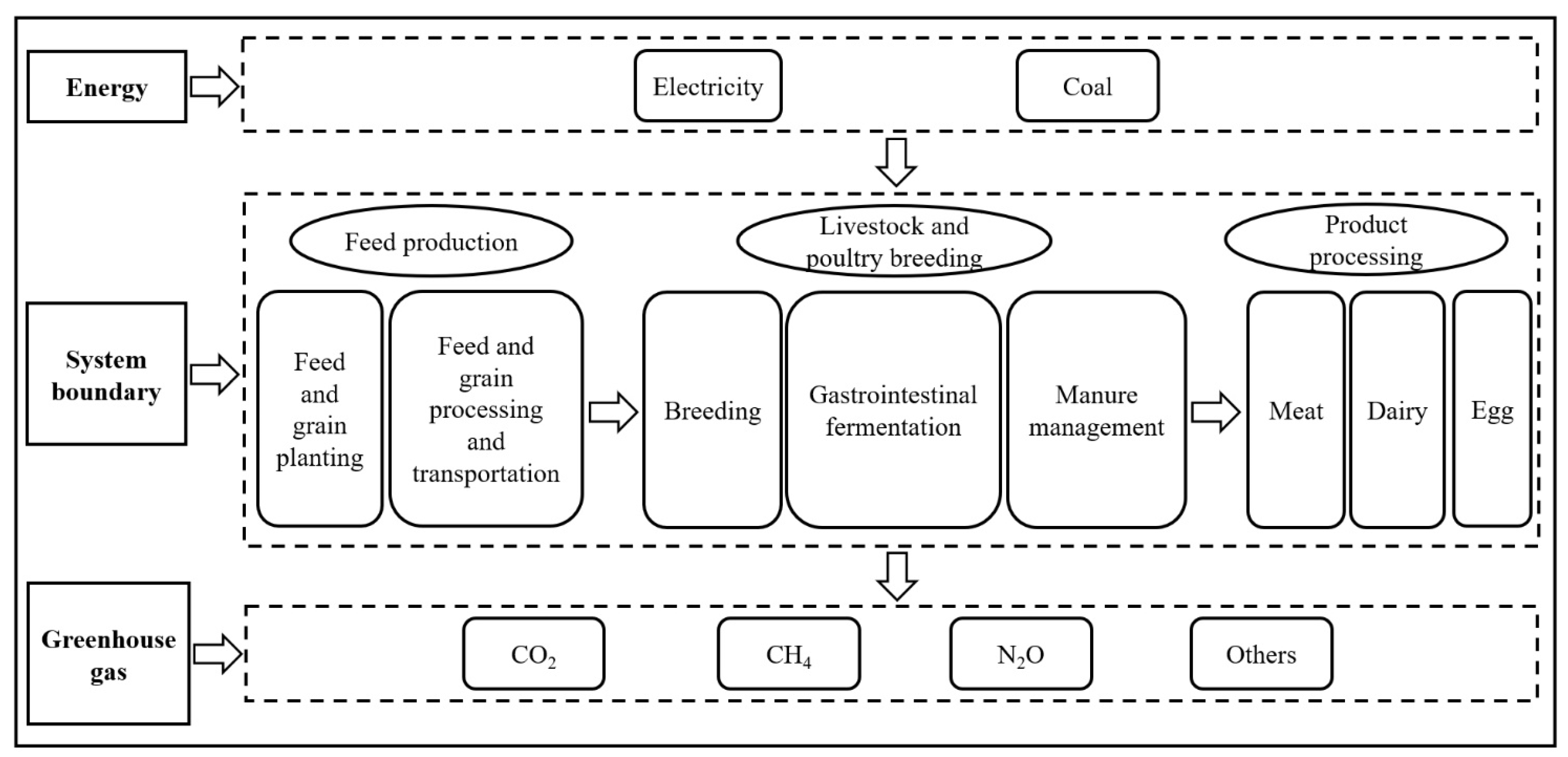
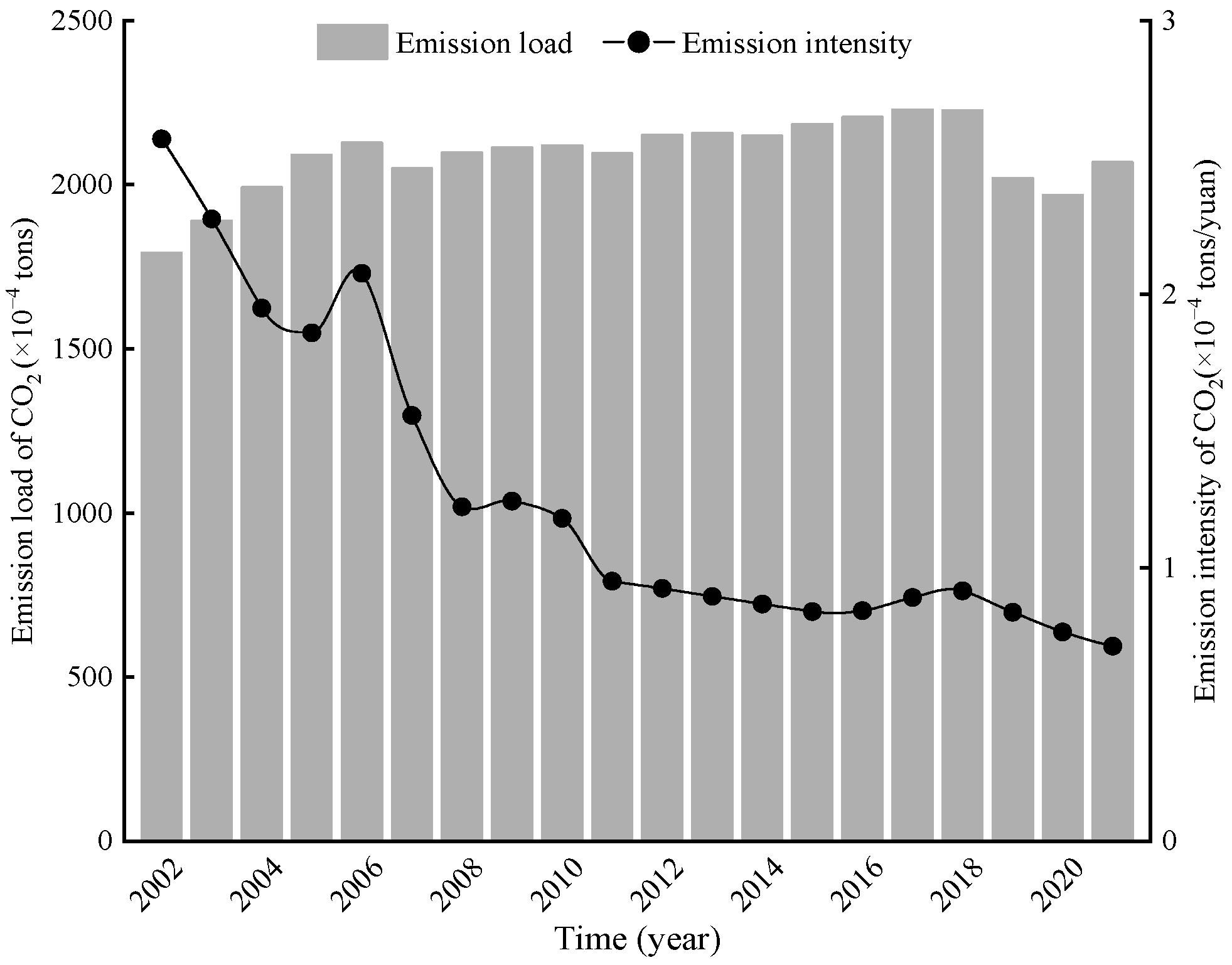
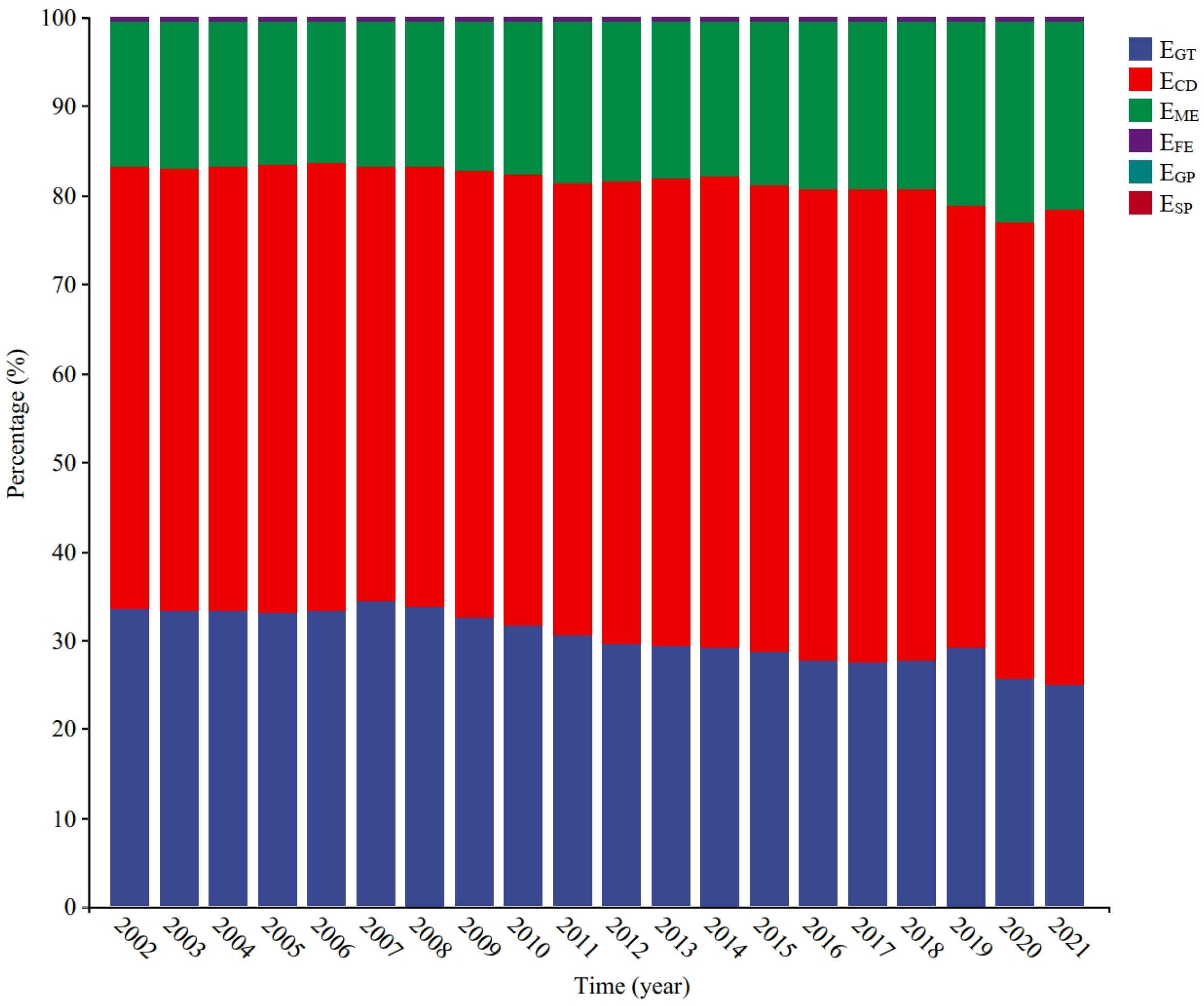


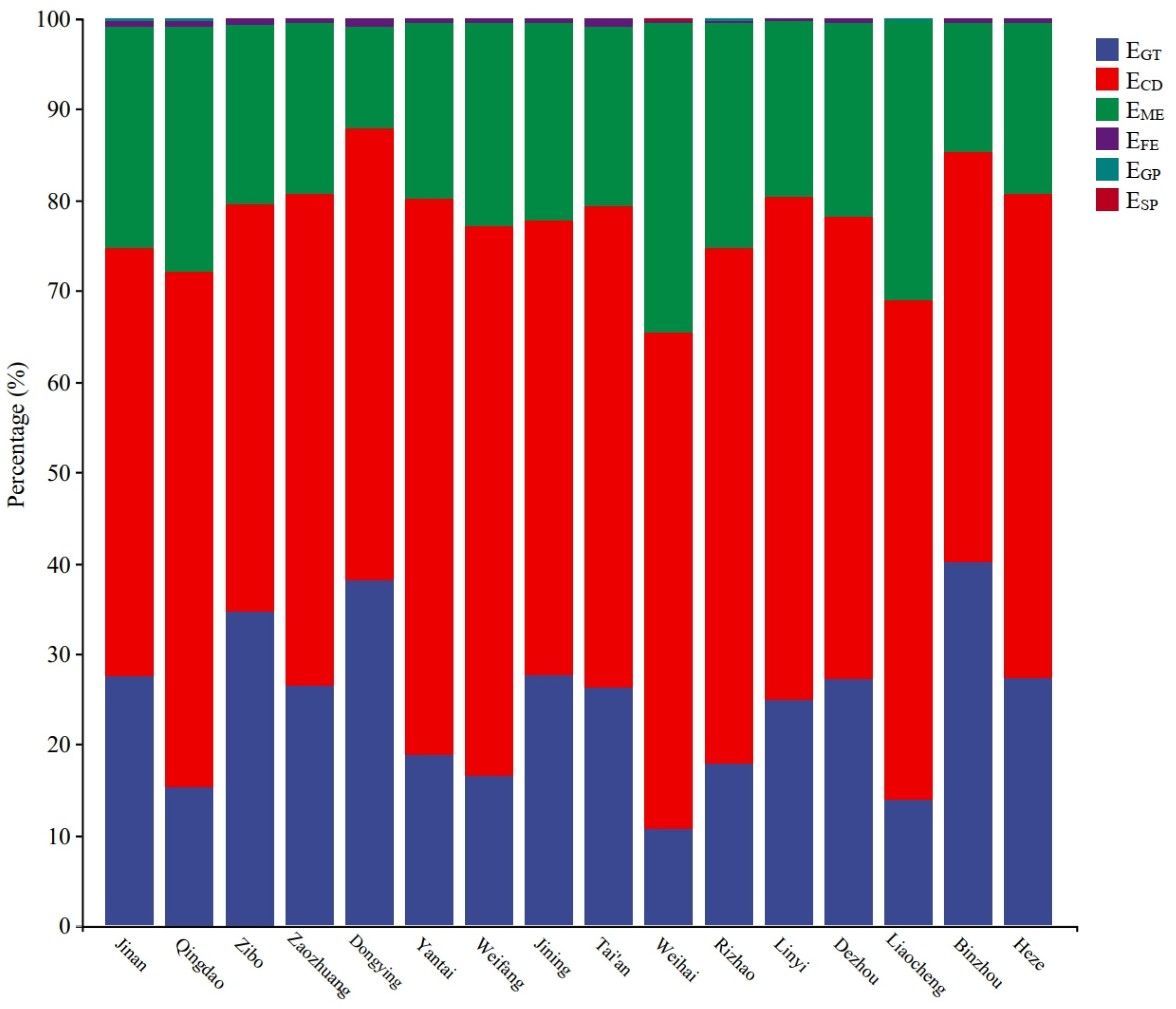

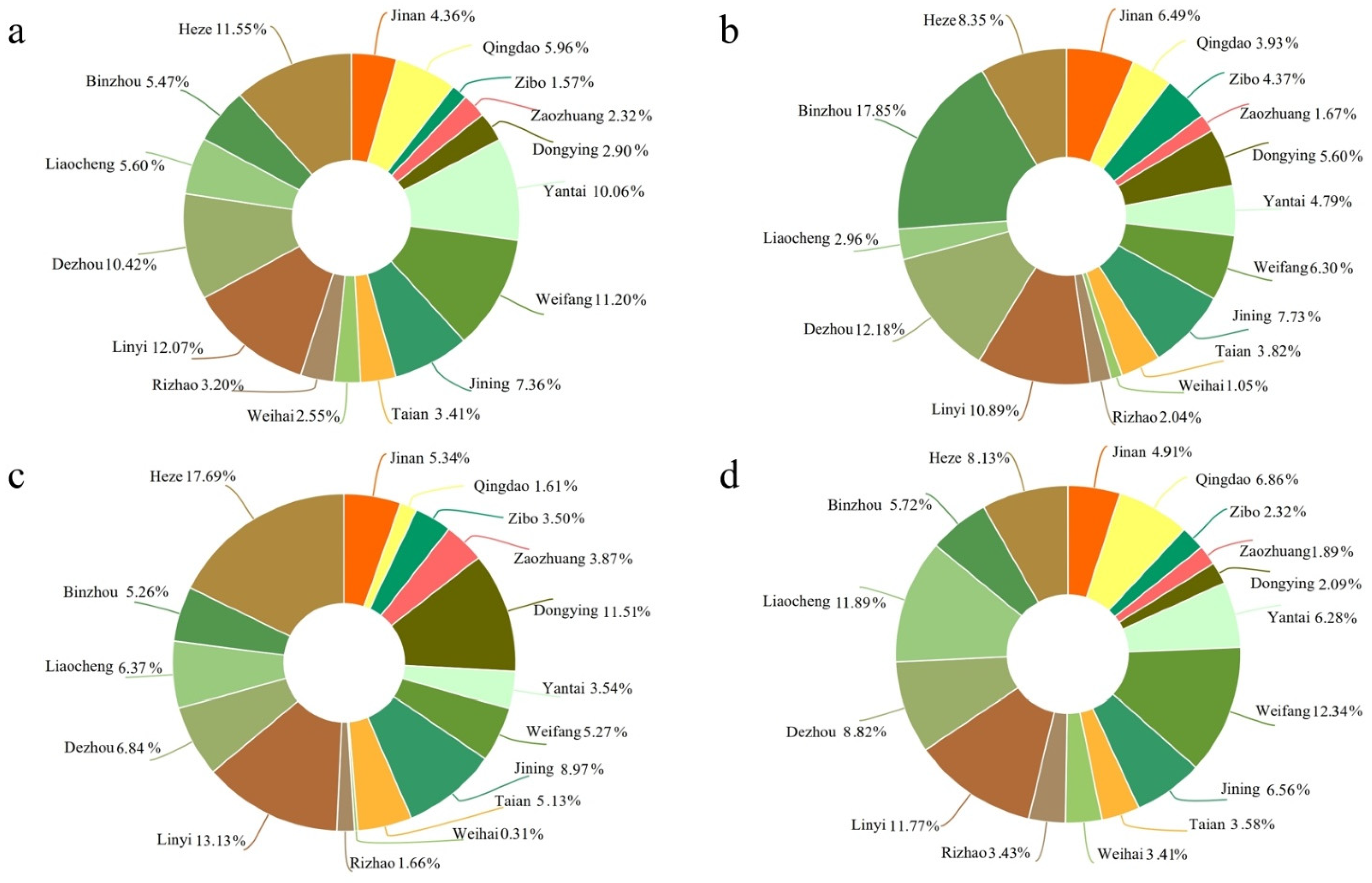
| Major Stages | Formula | Explanation | |
|---|---|---|---|
| Feed grain planting | (2) | Qi is the annual output of livestock and poultry products; ti is the grain consumption coefficient of unit livestock and poultry products; qj is the proportion of j-type grain in the formula of i-type livestock and poultry feed; efj1 is the CO2 equivalent emission coefficient of j-type grain. | |
| Feed grain transportation and processing | (3) | Qi is the annual output of livestock and poultry products; ti is the grain consumption coefficient of unit livestock and poultry products; qj is the proportion of j-type grain in the formula of i-type livestock and poultry feed; efj2 is the CO2 equivalent emission coefficient of j-type grain. | |
| Livestock and poultry breeding | (4) | NAPAi is the annual production of livestock and poultry; Cie is the electricity expenditure per head of livestock and poultry; Pe is the unit price of electricity for livestock and poultry breeding; efe is the CO2 emission coefficient of power consumption; Cic is the expenditure on coal consumption per head of livestock and poultry; Pc is the unit price of coal for livestock and poultry breeding; efc is the CO2 emission coefficient of coal consumption. | |
| Gastrointestinal fermentation | (5) | APPi is the average feeding amount of livestock; efi1 is the CH4 emission coefficient of gastrointestinal fermentation; GWPCH4 is the global warming potential of CH4. | |
| Manure management | (6) | APPi is the average feeding amount of livestock and poultry; efi2 is the CH4 emission coefficient of the manure management system; efi3 is the N2O emission coefficient of the manure management system; GWPCH4 is the global warming potential of CH4; GWPN2O is the global warming potential value of N2O. | |
| Product slaughter and processing | (7) | Qi is the annual output of livestock and poultry products; MJi is the energy consumption of slaughter and processing per unit of livestock and poultry products; en is the calorific value of one degree electricity; efe is the CO2 emission coefficient of power consumption. | |
| Total emissions | (8) | ET is total emissions; EFE is feed grain planting; EGP is feed grain transportation and processing; EME is livestock and poultry breeding; EGT is gastrointestinal fermentation; ECD is manure management; ESP is product slaughter and processing. | |
| Coefficient | Pig | Cattle for Beef | Dairy Cattle | Sheep | Poultry for Meat | Poultry for Egg | Unit |
|---|---|---|---|---|---|---|---|
| ti | 1.60 | 38.07 | 18.04 | 2.04 | 0.02 | 0.16 | t/t |
| efj1 | Corn: 1.50; wheat: 1.22; alfalfa: 0.27 | t/t | |||||
| efj2 | Corn: 0.0102; wheat: 0.0319; alfalfa: 0.002; soybean: 0.1013 | t/t | |||||
| Cie | 3.51 | 10.30 | 353.47 | 2.55 | 0.18 | 7.57 | CNY/head |
| Cic | 0.35 | 0.00 | 4.58 | 1.76 | 0.62 | 0.00 | CNY/head |
| Pe | 0.62 | CNY/(kW·h) | |||||
| Pc | 655.00 | CNY/t | |||||
| efe | 0.94 | t/(MW·h) | |||||
| efc | 1.98 | t/t | |||||
| efi1 | 1.00 | 51.40 | 68.00 | 56.00 | 0.00 | 0.00 | kg/(head·a) |
| efi2 | 3.54 | 1.50 | 16.00 | 0.16 | 0.02 | 0.02 | kg/(head·a) |
| efi3 | 0.53 | 1.37 | 1.00 | 0.33 | 0.02 | 0.02 | kg/(head·a) |
| GWPCH4 | 21.00 | / | |||||
| GWPN2O | 310.00 | / | |||||
| MJi | 3.76 | 4.37 | 1.12 | 10.40 | 2.59 | 8.16 | MJ/kg |
| en | 3.60 | MJ/(kW·h) | |||||
| Time | EGT | ECD | EME | EFE | EGP | ESP | ET |
|---|---|---|---|---|---|---|---|
| 2002 | 601.79 | 890.40 | 294.08 | 5.13 | 0.25 | 1.34 | 1792.99 |
| 2003 | 630.50 | 938.55 | 313.98 | 5.92 | 0.28 | 1.43 | 1890.65 |
| 2004 | 664.14 | 994.87 | 325.49 | 6.60 | 0.32 | 1.49 | 1992.89 |
| 2005 | 690.94 | 1051.44 | 339.97 | 7.14 | 0.34 | 1.55 | 2091.38 |
| 2006 | 708.70 | 1072.70 | 337.76 | 7.70 | 0.37 | 1.56 | 2128.80 |
| 2007 | 705.61 | 1000.73 | 335.37 | 7.17 | 0.34 | 1.44 | 2050.66 |
| 2008 | 704.78 | 1038.91 | 344.88 | 7.47 | 0.36 | 1.49 | 2097.89 |
| 2009 | 687.36 | 1061.08 | 355.82 | 7.57 | 0.36 | 1.53 | 2113.73 |
| 2010 | 669.72 | 1075.50 | 364.63 | 7.85 | 0.38 | 1.57 | 2119.65 |
| 2011 | 637.79 | 1069.48 | 379.09 | 8.04 | 0.39 | 1.61 | 2096.39 |
| 2012 | 635.09 | 1118.66 | 387.27 | 8.38 | 0.40 | 1.67 | 2151.47 |
| 2013 | 631.10 | 1132.75 | 382.88 | 8.22 | 0.39 | 1.66 | 2157.02 |
| 2014 | 627.16 | 1136.57 | 375.09 | 8.34 | 0.40 | 1.65 | 2149.21 |
| 2015 | 623.36 | 1149.20 | 401.58 | 8.31 | 0.40 | 1.73 | 2184.58 |
| 2016 | 613.12 | 1165.21 | 418.44 | 8.13 | 0.39 | 1.77 | 2207.06 |
| 2017 | 613.85 | 1183.29 | 421.31 | 7.73 | 0.37 | 1.84 | 2228.39 |
| 2018 | 618.49 | 1176.57 | 421.77 | 7.77 | 0.37 | 1.84 | 2226.81 |
| 2019 | 586.62 | 1006.77 | 417.58 | 7.44 | 0.36 | 1.69 | 2020.45 |
| 2020 | 504.35 | 1009.84 | 444.78 | 7.19 | 0.34 | 1.77 | 1968.27 |
| 2021 | 516.56 | 1104.52 | 438.14 | 8.22 | 0.39 | 1.82 | 2069.65 |
Disclaimer/Publisher’s Note: The statements, opinions and data contained in all publications are solely those of the individual author(s) and contributor(s) and not of MDPI and/or the editor(s). MDPI and/or the editor(s) disclaim responsibility for any injury to people or property resulting from any ideas, methods, instructions or products referred to in the content. |
© 2024 by the authors. Licensee MDPI, Basel, Switzerland. This article is an open access article distributed under the terms and conditions of the Creative Commons Attribution (CC BY) license (https://creativecommons.org/licenses/by/4.0/).
Share and Cite
Li, Z.; Wei, Q.; Liu, X.; Zhu, R.; Li, C.; Li, Z. The Emission Characteristics of Greenhouse Gases from Animal Husbandry in Shandong Province Based on Life Cycle Assessment. Sustainability 2024, 16, 1375. https://doi.org/10.3390/su16041375
Li Z, Wei Q, Liu X, Zhu R, Li C, Li Z. The Emission Characteristics of Greenhouse Gases from Animal Husbandry in Shandong Province Based on Life Cycle Assessment. Sustainability. 2024; 16(4):1375. https://doi.org/10.3390/su16041375
Chicago/Turabian StyleLi, Zemin, Qihang Wei, Xiayan Liu, Rongsheng Zhu, Cuilan Li, and Zhaojun Li. 2024. "The Emission Characteristics of Greenhouse Gases from Animal Husbandry in Shandong Province Based on Life Cycle Assessment" Sustainability 16, no. 4: 1375. https://doi.org/10.3390/su16041375
APA StyleLi, Z., Wei, Q., Liu, X., Zhu, R., Li, C., & Li, Z. (2024). The Emission Characteristics of Greenhouse Gases from Animal Husbandry in Shandong Province Based on Life Cycle Assessment. Sustainability, 16(4), 1375. https://doi.org/10.3390/su16041375





